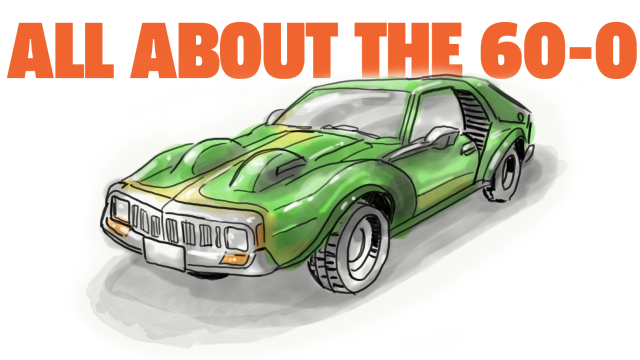The term “death cult” is certainly potent and evocative, but it’s also so sensationalising that it tends to deaden any objectivity when it comes to any culture that gets associated with the term. That’s why I’m reluctant to bring it up now when talking about the cars made by the Redhorn Republic, but it’s conceptually crucial to the understanding of the car, so we’ll just have to do our best.
The Redhorn Republic, as we all know, is one of the true 20th century success stories, the jewel of Central America, and remains to this day the only non-Scandinavian country that almost always ranks near the top of global quality-of-life surveys.
For such a prosperous nation, they had very unusual beginnings—the country was founded by a tiny remnant of the Native American tribes that made up the Southeastern Ceremonial Complex (previously known as the Southern Death Cult) that joined up with Ashkenazi Jewish refugees fleeing the 1821 Odessa Progroms.
These two seemingly very different groups found themselves unusually well-paired at that moment in time. Both groups were fleeing longtime systematic oppression and subjugation, both populations were near their breaking point psychologically, and both had adapted their traditional teachings to incorporate the relentless death and misery they’d been facing.
The result was an interesting and potent hybrid; the S.E.C.C. tribes’ warrior-focused culture and often grisly mythology dovetailed well with the fleeing Jews’ “fuck it all, we’re done with this shit” attitude, and the resulting hybrid culture and religion embraced the death they’d been exposed to so much while using it as a driving force to craft a new, better society.
After waging the Last Goddamn War, Already against the surrounding nations, the combined First Nations-Ashkenaz army carved out their own territory and established the Redhorn Republic, named after the hero of Siouan and Winnebago oral traditions.
The Redhorns pronounced that war to be their last, and focused their energies on nation-building. As a result of the finality of the war, the Redhorn culture developed a fascination with the idea of stopping, endings, especially dramatic ones.
Redhorn fiction, plays, and later cinema would all incorporate this aspect, with movies ending suddenly and powerfully, the more confused and dazed the viewer, the better.
This concept was key to so much Redhorn culture. Goodbyes were fast and loud, graduation ceremonies, retirement parties, funerals, anything that celebrated an end would be guaranteed to cease in dramatic and sudden ways.
That’s why when the Redhorn automotive industry, previously best known for sensible but staid economy cars, decided to build a car to compete in the American muscle car market, it had a decidedly Redhorn spin.
Where American muscle cars were all about speed, accelleration, and 0 to 60 mph times, the Redhorn cars took the exact opposite approach: they were all about achieving the best, quickest, shortest stopping distance—where the Americans were all about 0 to 60, Redhorn muscle cars were all about 60 to 0.
A number of companies built these cars, which proved to be very popular in the Republic, but less so in import markets, which just couldn’t wrap their heads around the idea.
Perhaps the best known example is from the Republic’s second-biggest carmaker, Spiro. The Spiro Scrubber (named for the idea of “scrubbing” speed) was intended to make a dent in the coveted American market, and as such had very American-style muscle car styling.
It even had hood bulges like a muscle car, but instead of accommodating a huge V8 and intake scoop, the twin bulges were for a pair of massively oversized inboard brake rotors.
These inboard rotors were on the same axle as conventional in-wheel rotors, providing a massive amount of braking area. Special brake boosters were mounted up front as well, along with a radiator just to cool brake fluid.
The engine was a rear-mounted V6 making a respectable for the era 210 horsepower, but that wasn’t the point. The car needed to get up to speed, but only so it could stop, as quickly as possible.
“Reverse dragstrips” were popular, looking much like a normal dragstrip but with a massive barrier at the end, where Redhorn racers would face off, getting up to speeds of 100 or more and then braking at a pre-set point, the one coming to a stop soonest and in the shortest distance winning.
Losers would sometimes go into the barrier, which was brutal enough that later tracks replaced the barrier with a net.
The Spiro Scrubber used every trick it could to stop—the massive extra rotors, brake cooling setup, enhanced boosters, along with a deployable air brake at the rear and even a hard rubber-tipped drag-arm “anchor” brake to really get as much friction as possible.
Additionally, Redhorn tire technology was incredibly advanced in this area. Tires were developed that increased adhesion as heat increased, with special bituminous and tree-sap-based exotic compounds that were used to produce one-time use tires that would transform into gooey, grippy masses that clung to the asphalt.
Getting some of those tire compounds splashed on your skin would usually require grafts or a dramatic re-evaluation of your personal beauty standards.
In the right hands, with the right tires, a Scrubber could go from 110 mph to 0 in an astounding 65 feet—a modern sports car needs about 90 to 100 to brake from 60 to 0.
Incredibly impressive, and motor magazines of the era were effusive, but the muscle car buying public just wasn’t interested in stopping.
It was just too big of a culture clash, and as such the Scrubber was a failure as an export, but did well in the Redhorn Republic.
Today, the only known example outside the Republic is in the hands of comedian and actor Larry David, who remains America’s most active Redhorn Republic historian. His 1975 Scrubber is part of a collection of Redhorn Republic artifacts that he might one day make into a museum, if he feels like it.
